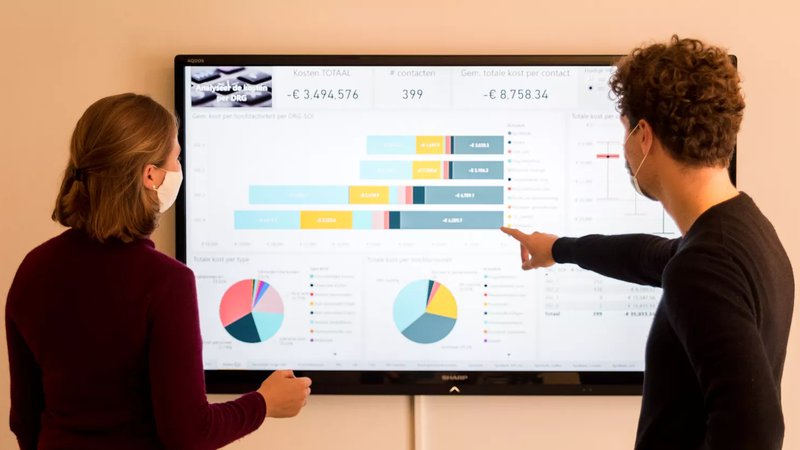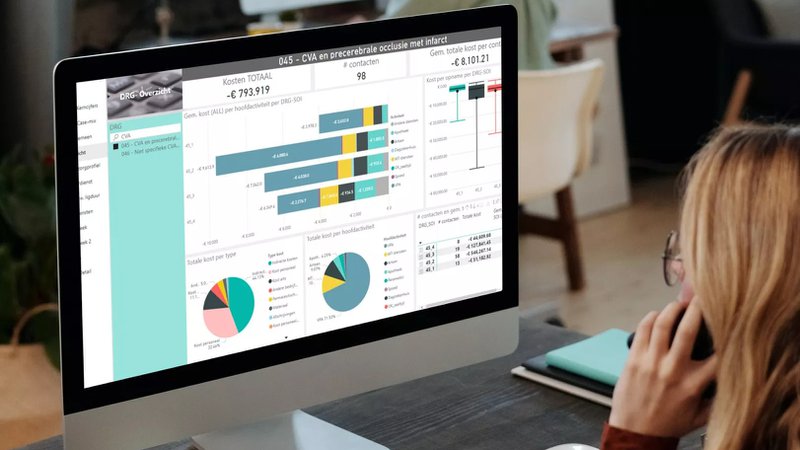How this tool enables hospitals to do more with the same resources: "Data is essential for improving patient care"

Tight margins, a new financing system, and a major outflow of exhausted healthcare staff: today, hospitals are facing a number of major challenges. Consulting firm Möbius developed Value4Health, a digital tool that allows hospitals to map and benchmark their costs and revenues with great precision. Consultant/developer Mathieu Dierick and user Frank Staelens (OLV Hospital Aalst) explain how the tool enables hospitals to do more with the same resources. "Data is essential for improving the quality of patient care without increasing costs."

Mathieu Dierick (Value4Health) and Frank Staelens (OLV Ziekenhuis Aalst)
Tight margins, a new financing system, and a major outflow of exhausted healthcare staff: today, hospitals are facing a number of major challenges.Consulting firm Möbius developed Value4Health, a digital tool that allows hospitals to map and benchmark their costs and revenues with great precision. Consultant/developer Mathieu Dierick and user Frank Staelens (OLV Hospital Aalst) explain how the tool enables hospitals to do more with the same resources.
Frank Staelens knows the hospital world inside and out. He has been working at OLV Hospital Aalst for 34 years. Today, he serves as Director of Processes and Quality.
“My department uses data to drive demonstrable quality improvements. That, in short, is my mission within the hospital. I've witnessed a huge evolution in the hospital sector. Ten years ago, we were considered a ‘soft’ sector. But with the rise of Value-Based Healthcare, we are now aiming to deliver more value to the patient without a corresponding increase in costs. In the end, it’s about doing more with the same — or even fewer — resources.”
“We also started looking beyond our sector, learning from how businesses operate. Terms like ‘optimization’ and ‘efficiency gains’ have become completely normal in hospitals today. I don't think our way of working is very different from that of companies. The big difference is that we are not driven by profit. We aim to break even — and ideally do even better — but any surplus is fully reinvested in innovation and better patient care.”
Data is essential for improving the quality of patient care without increasing costs.
"In fact, things are even tougher in a hospital than in an average company. We don't get to choose which patients we admit — they come to us via the emergency department, through their general practitioner, and so on. We also don't set the prices our patients pay; we operate within the framework established by the government. Our room for maneuver is limited, so we have to be very creative to provide the best possible care to our patients with the resources we have."
"We are constantly walking a tightrope. Suppose robotic surgery costs us more than it brings in, but it clearly offers added value for the patient. What do we do then? In practice, we will always choose what is best for the patient, but it also means we have to find a way to compensate for those additional costs. These are the kinds of trade-offs we have to make every single day."
Digitizing and structuring a mountain of data
"Hospitals have access to a massive amount of data. We have always had that data, but the big problem was that it was not anchored. It was not digitized, and it was not structured. Thanks to solutions like Value4Health, we are now able to get much more value from the data we have available."
Thanks to solutions like Value4Health, we are now able to get much more out of the data we have available.
Mathieu Dierick helped lay the foundations of Value4Health at Möbius. He is an atypical consultant who not only advises hospitals but also builds technological tools himself.
"We started with the data that hospitals already had. That data is complex enough, so we certainly did not want to add new data streams or impose new data registration requirements. We brought together all the data sources, which were often scattered across different departments, and connected them. This way, hospitals can discover new insights."

Anticipating new financing
"With Value4Health, hospitals can map their costs and revenues in detail, at the level of pathologies or patient groups," Dierick explains.
"This is particularly important now that the federal government is planning to change hospital financing. Today, hospitals are paid by the government per service provided. In the future, the government wants to move away from this service-driven model and instead give hospitals a fixed amount per patient group. To know what they can do with that budget, it is crucial for hospitals to have a reliable view of the costs and revenues for each patient group."

"In addition, hospitals can also benchmark themselves against other hospitals. It is only by comparing their own costs and revenues with those of other comparable hospitals that they can assess where they are doing well and where there is still room for improvement. For a long time, the hospital sector was made up of isolated islands. It is only in recent years that more and more networks have started to form, and hospitals have begun to share knowledge and experiences with each other."
Learning from other hospitals
The benchmarking feature was the main reason OLV Hospital decided to use Value4Health, says Staelens.
"We already had a fairly accurate view of our costs and revenues. But you should never be so presumptuous as to think you know better than everyone else. There is no need to reinvent the wheel every time. We can undoubtedly learn a lot from other major hospitals, just as they can learn from us."
"The biggest challenge for hospitals today is finding enough qualified staff. COVID-19 caused a major outflow, and every hospital has seen many people leave. Some, hopefully, only temporarily, others permanently. We have to deploy our people as smartly as possible, putting the right people in the right place, and we must ensure that their tasks remain sufficiently challenging without becoming too overwhelming."
All hospitals are in the same boat today. We can learn from each other. Maybe we need to organize ourselves differently. Maybe we need to adjust our processes. The ultimate goal, of course, is always the quality of patient care, which must demonstrably improve or at least be maintained with every change we make."

"Value4Health is a solution to complement Business Intelligence and financial profiles," Dierick emphasizes.
"There is also a major shortage of those profiles in hospitals. By partially digitalizing their work, we help to address that shortage. In the future, we also want to include care organization in the benchmarking. In projects, we see that some hospitals had an overcapacity during night shifts. By adjusting shift planning and moving people to day shifts, they can have more hands at the bedside with the same staffing levels."
Customer experience and patient experience
Hospitals are looking at how businesses operate to optimize and improve the efficiency of their patient care. But Staelens is convinced that entrepreneurs can also learn a lot from hospitals. "Every company claims to be customer-driven and to put the customer at the center."
"The way we put our patients at the center, listen to them, and involve them in our quality improvement efforts is something I honestly do not see many companies doing. We have a patient platform that meets four times a year. We also set up focus groups to think together about how we can further increase patient involvement."
The way we put our patients at the center, listen to them, and involve them in our quality improvement efforts is something I honestly do not see many companies doing.
"At the individual level, we carry out two measurements for every single patient. The Patient Reported Outcome Measure (PROM) assesses the objective result of a treatment, while the Patient Reported Experience Measure (PREM) examines how the patient experienced the treatment. In a way, we measure the 'customer experience' for every patient. How many businesses can say they do that?"
"At Möbius Healthcare, we support care organizations in delivering more and better care at lower costs. That was the starting point for Value4Health and it remains our core mission. Benchmarking data is only silver. Coming together and learning from each other's practices is gold."
Get in Touch with Us
Do you have questions or need assistance? Our team is here to help you optimise your hospital's operations and financial sustainability.


